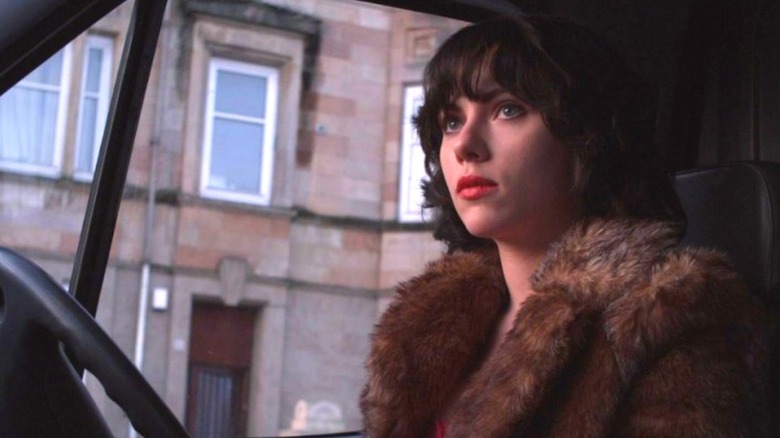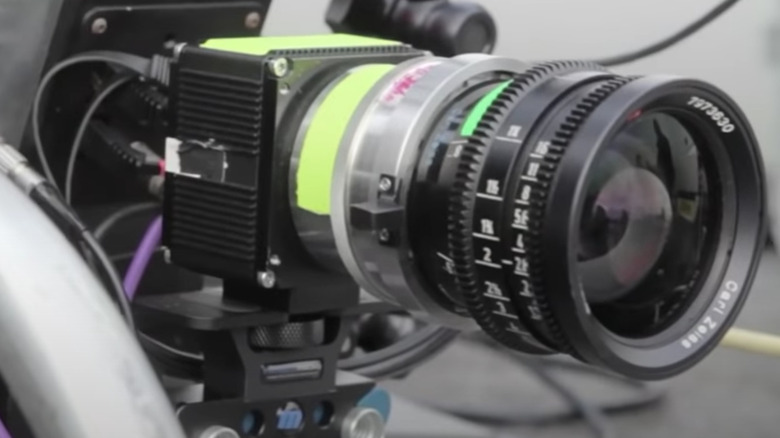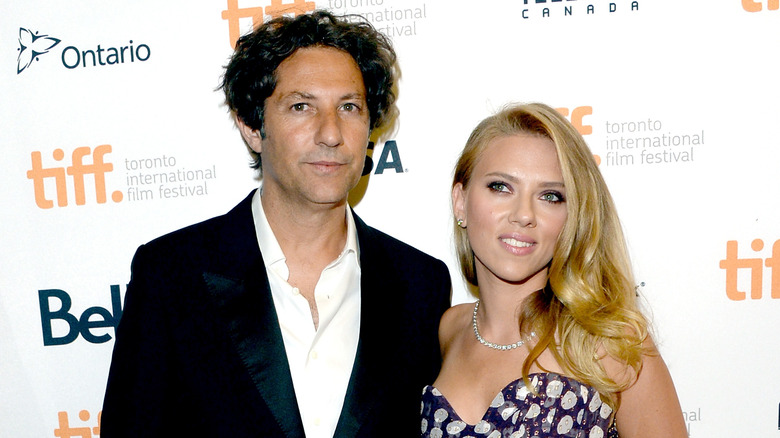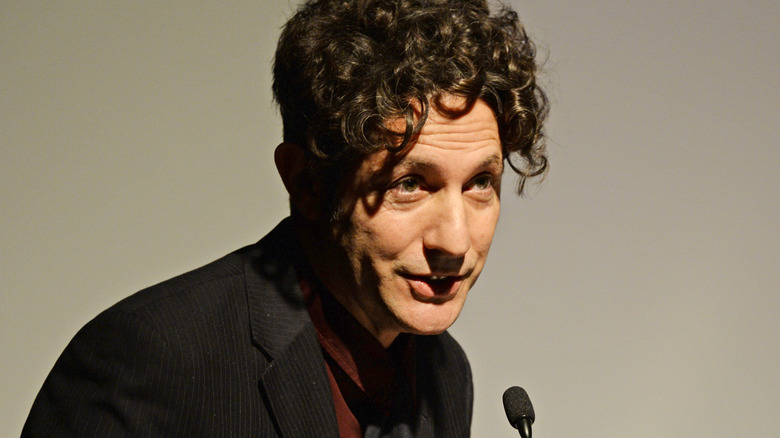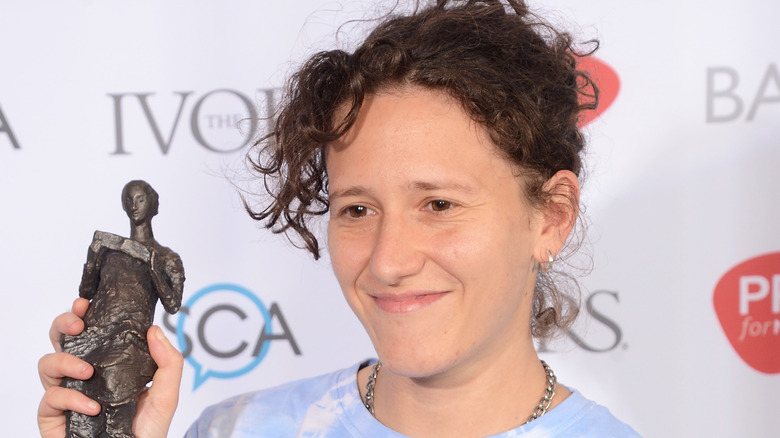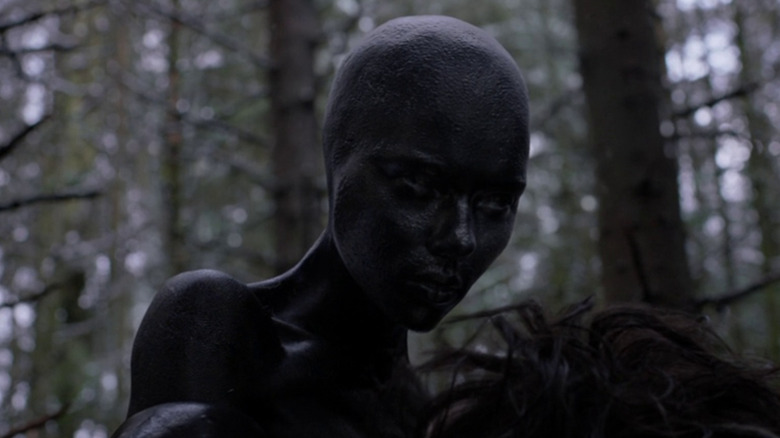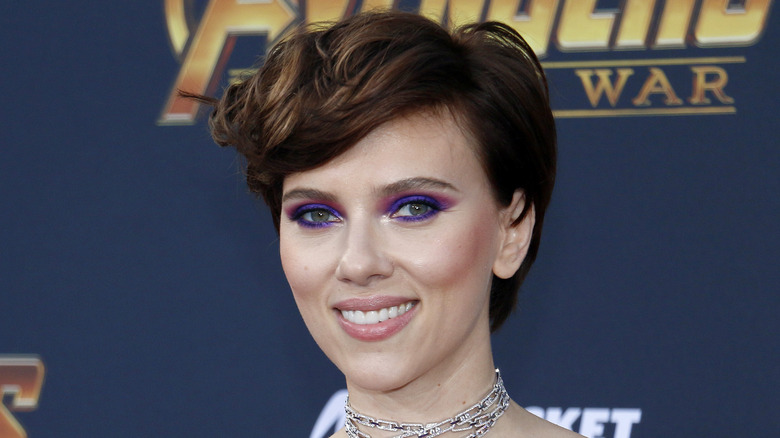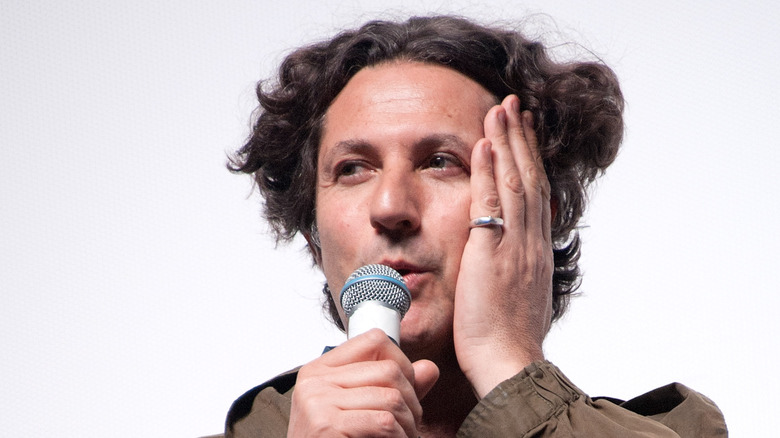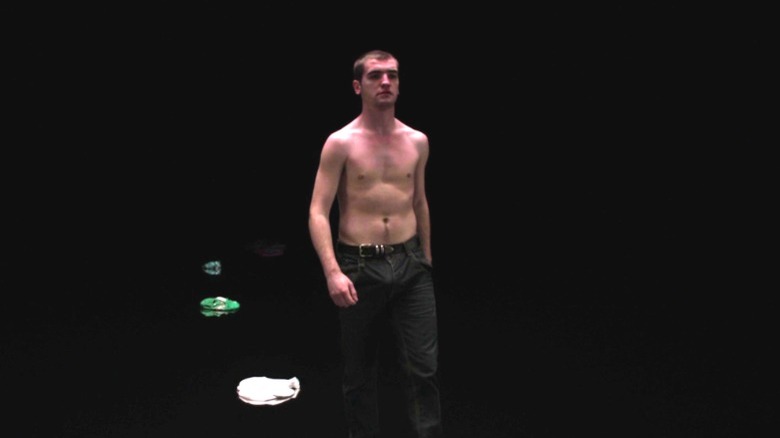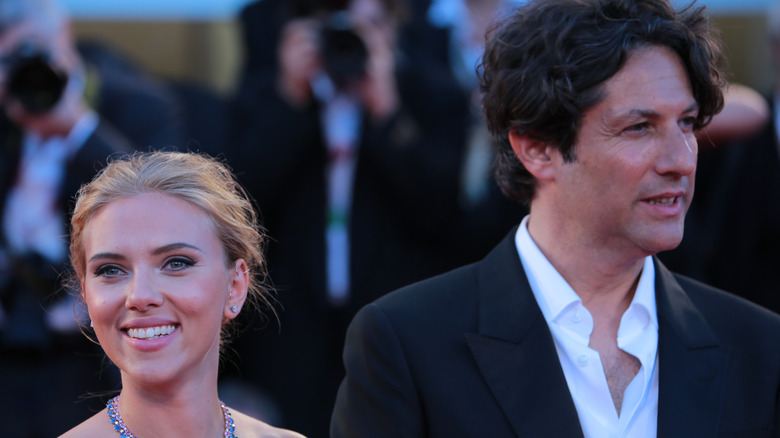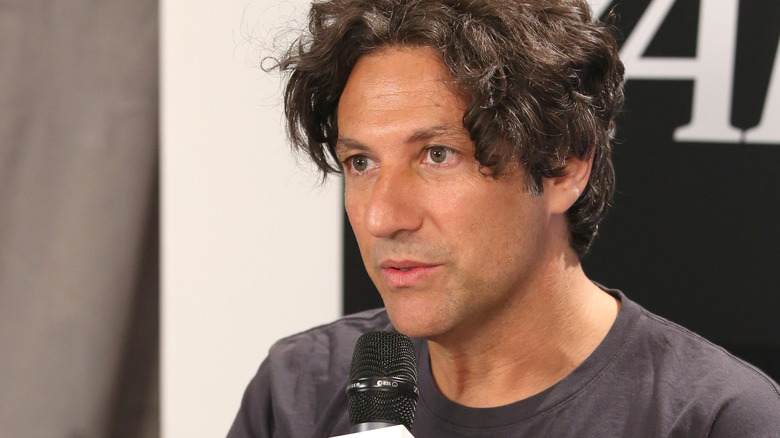The Untold Truth Of Under The Skin
One of the most striking and memorable entries in the sci-fi genre in recent years was 2013's "Under the Skin." Though it stars one of Hollywood's biggest leading ladies — Scarlett Johansson — "Under the Skin" makes no attempt to fit the mainstream mold. Consequently, while this unique and hard-to-define piece of work was a hit with critics, it polarized audiences with its enigmatic themes and atypical approach to narratives.
"Under the Skin" brings an abstract, arthouse method to the story of an alien prowling the streets of Glasgow to lure in young men and harvest them. The story is simple, but the way in which it is told is anything but. Rather than placing its focus on plot, "Under the Skin" prioritizes atmosphere, mood, and theme. The film is fascinating enough when watching it on its own, but the experience becomes even more impressive when you learn about the unique filmmaking techniques that were utilized to bring the movie to life. From its unorthodox behind-the-scenes process to the unusual priorities of its director, this is the untold truth of "Under the Skin."
Much of the film was shot using hidden cameras
While hidden cameras are sometimes used in game show, reality TV, or prank productions, they are hardly ever used in narrative filmmaking. "Under the Skin" bucks this trend by shooting much of its footage using hidden cameras (via The New York Times). Many of the people in the movie were non-actors; instead, they were everyday people who had no idea they were on camera thanks to this filming style and Scarlett Johansson's simple but effective disguise.
Director Jonathan Glazer wanted to capture the utmost realism for the movie, and filming genuine human interactions was the best way to do that. He explained to The New York Times that hidden cameras were mounted inside of the van that Johansson drives around, as well as positioned in various secret spots on the streets and inside structures. Glazer told The Dissolve that as many as 10 hidden cameras were used at any given time to capture unscripted scenes from several angles simultaneously.
Glazer received pushback for wanting to shoot the film in this unorthodox style. Producer Jim Wilson was against the idea and pleaded with him to ditch the hidden cameras and cast extras the typical way (via The Guardian). But Glazer did things his own way regardless and in fact, this wasn't the first time he had used hidden cameras for a film project. In an interview with Film4, Glazer noted that he once used 57 hidden cameras simultaneously to film a woman running up a street for a short-form project.
A new type of camera was invented for the film
The unusual choice to shoot so much of "Under the Skin" with hidden cameras brought with it some additional challenges and limitations, both of the creative and technical varieties. Perhaps the biggest challenge associated with this unique filmmaking process was finding cameras small enough to hide in plain sight, but which were also powerful enough to deliver feature film-quality images.
Most hidden cameras are not designed for big cinema screens and they produce lower quality footage than Jonathan Glazer considered acceptable for the film. After extensive searching, the production team realized that the type of camera they needed in order to meet both their covert and image quality demands didn't yet exist.
Rather than giving up on the idea of using hidden cameras or settling for lower image quality, innovation took hold. A new type of camera was invented specifically for "Under the Skin." The film's cinematographer Daniel Landin spoke to IndieWire about this custom creation, called the One-Cam. Although it was just the size of a matchbox, it could be fitted with cinema lenses and deliver the high quality visuals Glazer needed. It was a hit with the crew as Landin noted, "The image we generated we ended up liking so much, we would have shot the entire film on that camera if we could have made it rugged enough to withstand all kinds of weather." The One-Cam was developed by a VFX studio called One of Us, which also handled the visual effects for the film.
Scarlett Johansson took a risk because she was a fan of the director
When looking at the entirety of Scarlett Johansson's filmography, "Under the Skin" sticks out a bit with its avant-garde and arthouse stylings. At the time she starred in this enigmatic horror/sci-fi movie, she was already one of Hollywood's biggest leading ladies thanks to her turn as the Black Widow in MCU movies like "Iron Man 2" and "The Avengers."
Taking on the lead role in "Under the Skin" meant making a huge shift in terms of budget/pay and audience reach. However, in an "Under the Skin" featurette, Johansson talked about her decision to get on board with this unusual project that was so different from her other films: "I love Jonathan's work and that's what originally drew me to the project ... We had an incredibly close relationship and I couldn't have done it if we didn't have that."
In an interview with The Guardian, Johansson noted that she was eager for the opportunity to work with Glazer — whom she called a "visionary" and "genius" in a press conference — and take up a role unlike others: "I thought it would be incredibly challenging to play a character that's free of judgment, that has no relationship to any emotion I could relate to." Additionally, the role required her to learn how to drive a van, perform nude scenes, and interact with real people on hidden cameras without being recognized. All of these demands certainly provided Johansson with a drastic change of pace from the blockbuster fare she was beginning to become known for at the time.
The director's background is in music videos and commercials
Though his directing career has spanned decades, Jonathan Glazer has made only three feature films: "Sexy Beast," "Birth," and "Under the Skin." That isn't to say that his directorial output is slow or that he takes his time between projects, but rather that his attention is often focused in directing non-movie projects. The majority of Jonathan Glazer's filmmaking endeavors have been spent directing television commercials and music videos for various bands (via IndieWire).
Glazer's ads are typically striking, cinematic, and work like his Guinness "Surfer" commercial have been called groundbreaking and won him numerous advertising awards (via Academy Films). His music videos for bands like Radiohead and Jamiroquai have similarly been hailed as revolutionary and been nominated for or won top industry awards (via IMDb). In fact, he won the first ever Icon Award at the UK Music Video Awards (via Billboard).
However, in an interview with The Guardian, Glazer noted that a commercial he directed for Cadbury landed him in hot water. The ad featured a chocolate demon and was hated by the brand, who considered it controversial and didn't allow it to air. The ad later leaked online, landing Glazer in even more trouble from the lawyers of the Cadbury company. The ordeal damaged Glazer's reputation in the advertising world, but luckily his reputation as a filmmaker has only grown in the years since.
The soundtrack was made by a first-time composer
"Under the Skin" is heavy on atmosphere, mood, and tone, but light on story and dialogue. As such, the film's score is front and center. The haunting soundtrack is one of the most striking and memorable aspects of "Under the Skin," and it might come as a shock to learn that this incredible original score was created by a first-time composer.
The film's captivating soundtrack was created by Mica Levi in their very first composer credit (via The Film Programme). Though they were new to creating music for films, Levi was no stranger to music. Before composing, Levi was best known by the stage name Micachu and for helming the band Micachu and the Shapes, whose name was later changed to Good Bad Happy Sad (via Pitchfork).
Jonathan Glazer specifically wanted to find a first-time composer for the project. In an interview with The British Film Institute, Levi said, "I think he wanted a novice — someone who didn't know how to write film scores. He didn't want the score to manipulate the audience unnecessarily." These days, Levi is a seasoned pro at composing original film scores. In the years since "Under the Skin," Levi has gone on to compose the music for "Jackie," "Marjorie Prime," and two installments of Steve McQueen's "Mangrove" film collection. Levi later reunited with Jonathan Glazer in 2019 to compose the music for his short film "The Fall."
The film bears little resemblance to its source novel
"Under the Skin" is an adaptation of the novel of the same name written by Michel Faber, but it bears very little resemblance to its source material beyond the title and basic premise. Jonathan Glazer and co-writer Walter Campbell changed up almost everything about the story when writing the screenplay. In an interview with DP/30, Glazer noted he didn't want to make a literal adaptation of the book, while Scarlett Johansson described the original version of the script, which was a two-hander about aliens assimilating into society.
In the end, the book is more like an inspirational jumping off point rather than actual source material for Glazer's vision. The film is ambiguous, mysterious, and extremely cryptic, while the book spells everything out quite explicitly. The book also includes much more information about the protagonist's task and the alien home world she comes from, which isn't touched on at all in the movie. The film keeps everything shrouded in mystery, including its open-to-interpretation ending and the main character's name. Scarlett Johansson is credited simply as "The Female," while the book's protagonist is named Isserley.
Scarlett Johansson was involved in the creative process years in advance
In an interview with The Guardian, Scarlett Johansson revealed that she spent several years discussing the project with Jonathan Glazer ahead of actually shooting the movie. Throughout these years, she watched the script and the overall film change drastically in style and content. As the script changed, Johansson's star power rose considerably over the years as well, but she still remained committed to the project due to the trust and admiration she had for Glazer as a filmmaker.
Johansson is the only big-name actor in the cast, and one of very few real actors in the film altogether, since many of the people in the movie are real Glasgow residents filmed on hidden cameras. In an interview with Film4, Glazer noted how part of the overall concept for the film was to put a single big Hollywood star into the real world as a way to parallel the experience of the alien protagonist interacting with humans, which can be seen as a comment on how celebrities exist as almost separate creatures from everyday people.
Jonathan Glazer spent a decade trying and failing to make Under the Skin
Before making his second feature film "Birth," Jonathan Glazer originally planned to make "Under the Skin" as his sophomore effort, but it wound up taking more than an entire decade to come to fruition. In an interview with The Guardian, Glazer explained how he was initially approached by producer Jim Wilson to make the movie after Wilson optioned the rights to the "Under the Skin" novel.
The first draft of the "Under the Skin" screenplay was written before Glazer was attached to the project and before he had even finished making his first film, "Sexy Beast." Glazer disliked this initial draft of the script because it was too faithful to the novel, an issue that he described to DP/30 as the difference between filming the book and turning the book into a film.
Over the years, Glazer went through countless variations on the core concept, scrapping them all one by one. Eventually, he figured out the right angle for the story: What would an alien's perspective of our world be? He told The Guardian he related to that on a personal level: "I suppose I must have that alien thing in me to start with ... I do feel outside. Not entirely, but I do. I've had that about me since quite a young age I think." With his take on the film clear, Glazer was finally able to make "Under the Skin" almost 10 years after 2004's "Birth," and continue his streak of making some of the most evocative and disturbing movies of recent memory.
Brad Pitt was almost in the film
In the final state in which "Under the Skin" was released, it is difficult to imagine Brad Pitt starring in the film, not least of all because there isn't a single substantial male role in the entire movie. The adapted screenplay for "Under the Skin" changed drastically throughout the years before production, and one particular version of the script followed a pair of male and female aliens posing as a human couple of Scottish farmers, rather than the lone female alien that the finished film follows (via Screen International).
According to Screen International, Brad Pitt was attached to play the husband alien. Like Scarlett Johansson, he was a fan of Jonathan Glazer's prior projects and was eager to work with him. The producers attempted to raise funding for the film with Pitt's name attached, but didn't find much success. Glazer ended up retooling the entire story regardless by stripping the screenplay of any pages that didn't have to do with the female character. He and producer Jim Wilson eventually had to tell Pitt that the film was moving forward in a new direction that no longer included his character at all.
Jonathan Glazer called the book trashy
In an interview with IndieWire from way back in 2001 — 12 years before the release of "Under the Skin" — Jonathan Glazer called the novel "a great book, but a trashy book." However, he also noted "there's an incredible gem at the heart of [the novel]." When he spoke with The Guardian years later in 2014, Glazer seemed to regret calling the book trashy and at that time, he hadn't yet met Faber. But in an interview later that year with The Dissolve, Glazer noted that he did finally meet Faber, who was "relieved at the fact that [the movie] was its own thing entirely, and it was a spiritual bedfellow, or soulmate."
Although Jonathan Glazer and Michel Faber might not have met up to discuss their different interpretations of the story before Glazer made his movie, Faber has shared his opinion on the film. In an interview with film critic Gabriel Diego Valdez, Faber revealed that he appreciated how the film took viewers outside of their typical comfort zones and liked how different the film was from his book.
Both Faber and Glazer aligned on the idea that a faithful adaptation would be a bad idea, with Faber saying that his main concern with film versions of his books is "that they should be strong works of art in themselves. A mediocre or weak adaptation that tried to be faithful would have upset me; a strong adaptation that took wild liberties made me very happy."
The alien environments came from the limits of human imagination
Sci-fi films typically feature complex tech and machinery whenever aliens are involved. "Under the Skin" is an alien film like no other, and its distinctive nature is reflected in the design elements as well. There are a couple of alien environments shown in the film, but they look unlike the alien environment shown in any other movies. During an interview with Film4, Jonathan Glazer revealed that he decided early on to steer his production designers and VFX artists away from the typical sci-fi designs. He didn't want to pull any inspiration from prior alien design aesthetics and instead sought to create a look that was purely alien.
He described the endeavor as somewhat of a futile task because at the end of the day, they were using human brains to try to conceive of something inhuman. And thus the minimalist design approach for the alien environments was born. As Glazer put it, the solid white and solid black spaces strive to "bypass the intellect." His intent was to create spaces that were more felt than thought. In doing so, he made a conscious decision to steer more towards dream/nightmare territory rather than the more typical technologically focused designs found in other sci-fi films. He described the environmental designs as "trying to get to the inner consciousness of things."
Jonathan Glazer often abandoned the script entirely
After spending so many years working and reworking the screenplay for "Under the Skin," it might come as a surprise to learn that Jonathan Glazer still wasn't satisfied with it by the time he shot the movie. In his head, he had boiled the entire story down to what he called the "molten core" of the concept (via Screen Daily). This core served to guide the film from scene to scene more than the script.
When speaking with DP/30, Scarlett Johansson said that they would often begin shooting a scene following the script, only for Glazer to become frustrated with the scripted material and throw it out: "It was so obvious that Jonathan would just hate it, and it wasn't real and it didn't feel right. It was fake." They would then spend an entire day on set rebuilding the scene from the ground up until it worked. Shooting this way leant the project an additional experimental component and kept things exciting and fresh on set but it also meant that filming took far longer than it would have otherwise.
The movie almost had no music at all
Mica Levi's score is an integral element to "Under the Skin," but the movie was almost devoid of music altogether. In the early stages of planning the film, Jonathan Glazer had decided to avoid having any music in the film until the point where a human plays a record for the alien character within the movie (via Film4). The idea was to keep the viewer in the alien protagonist's shoes and deny them music until that character hears it for the first time. An added benefit of this decision for Glazer was that it meant the music budget for the film would be kept extremely low.
It wasn't until the movie was already shot and the editing process was underway that Glazer changed his mind. He realized the pitfalls of playing the majority of the film without music and found that the moment the alien was shown a record wasn't having the special impact he had wanted it to have anyway. He then decided that music was needed throughout the film and sought to make it an integral element of the movie's atmosphere. Mica Levi was brought on board after a rough cut of "Under the Skin" was already completed and subsequently spent several months crafting the original score.
Jonathan Glazer didn't care what the movie looked like
In an interview with Film4, Jonathan Glazer described how he wanted the visual aesthetic of the movie to be that "there was no aesthetic." He didn't care if the movie looked good because it was important to him that "it felt unadorned ... it should be as it was." This decision to avoid any sort of visual flair stemmed directly from the same source of inspiration that led to using hidden cameras: his desire to achieve the highest level of realism possible.
Glazer said that he would have made the movie with no star, no lights, and no camera if that were possible. He also described wanting to use natural light exclusively and asking his cinematographer to use as little artificial light as possible. This was an extra challenge during the night-time scenes because several were shot on the small sensors of the hidden cameras. This desire for the film to look "unadorned" can also been seen in the alien environments as well with their solid white and solid black designs.
Speaking with Slant Magazine, Glazer further explained his relationship with visual aesthetics, which are secondary to the atmosphere and for him, can't lead the film: "The aesthetics have to flower to form the essence of what you're trying to do."

